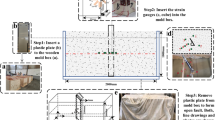Abstract
The staggered grid finite-difference method is a powerful tool in seismology and is commonly used to study earthquake source dynamics. In the staggered grid finite-difference method stress and particle velocity components are calculated at different grid points, and a faulting problem is a mixed boundary problem, therefore different implementations of fault boundary conditions have been proposed. (1982) chose the shear stress grid as the fault surface, however, this method has several problems: (1) Fault slip leakage outside the fault, and (2) the stress bump beyond the crack tip caused by S waves is not well resolved. (1998) solved the latter problem via thick fault implementation, but the former problem remains and causes a new issue; displacement discontinuity across the slip is not well modeled because of the artificial thickness of the fault. In the present study we improve the implementation of the fault boundary conditions in the staggered grid finite-difference method by using a fictious surface to satisfy the fault boundary conditions. In our implementation, velocity (or displacement) grids are set on the fault plane, stress grids are shifted half grid spacing from the fault and stress on the fictitious surface in the rupture zone is given such that the interpolated stress on the fault is equal to the frictional stress. Within the area which does not rupture, stress on the fictitious surface is given a condition of no discontinuity of the velocity (or displacement). Fault normal displacement (or velocity) is given such that the normal stress on the fault is continuous across the fault. Artificial viscous damping is introduced on the fault to avoid vibration caused by onset of the slip. Our implementation has five advantages over previous versions: (1) No leakage of the slip prior to rupture and (2) a zero thickness fault, (3) stress on the fault is reliably calculated, (4) our implementation is suitable for the study of fault constitutive laws, as slip is defined as the difference between displacement on the plane of z=+0 and that of z=−0, and (5) cessation of slip is achieved correctly.
Access this chapter
Tax calculation will be finalised at checkout
Purchases are for personal use only
Preview
Unable to display preview. Download preview PDF.
Similar content being viewed by others
References
Andrews, J. (1976), Rupture velocity of plane strain shear cracks, J. Geophys. Res. 81, 5679–5687.
Andrews, J. (1985), Dynamic plane-strain shear rupture with a slip-weakening friction law calculated by a boundary integral method, Bull. Seismol. Soc. Am 85, 1–21.
Andrews, J. (1999), Test of two methods for faulting in finite-difference calculations, Bull. Seismol. Soc. Am. 89, 931–937.
Aochi, H. and Fukuyama, E. (2002), Three-dimensional nonplanar simulation of the 1992 Landers earthquake, J. Geophys. Res. 107, 10.1029/2000JB000061.
Das, S. and Aki, K. (1977), A numerical study of two-dimensional spontaneous rupture propagation, Geophys. J. R. Astr. Soc. 50, 643–668.
Day, S. (1982), Three-dimensional finite-difference simulation of fayult dynamics: rectangular faults with fixed rupture velocity, Bull. Seismol. Soc. Am. 72, 705–727.
Fukuyama, E. and Madariaga, R. (1995), Integral equation method for plane crack with arbitrary shape in 3-D elastic medium, Bull. Seismol. Soc. Am. 85, 614–628.
Graves, R. W. (1996), Simulating seismic wave propagation in 3-D elastic media using staggered-grid finite differences, Bull. Seismol. Soc. Am. 86, 1091–1106.
Hu, L. and McMechan, G. A. (1988) Elastic finite-difference modeling and imaging for earthquake sources, Geophys. J. 95, 303–313.
Kikuchi, M. and Fukao, Y. (1976), Seismic return motion, Phys. Earth Planet. Inter. 12, 343–349.
Kostrov, B. (1964), Self-similar problems of propagation of shear cracks, J. Appl. Math. Mech. 28, 1077–1087.
Madariaga, R. (1976), Daynamics of an expanding circular fault, Bull. Seismol. Soc. Am. 66, 639–667.
Madariaga, R., Olsen, K., and Archuleta, R. (1998), Modeling dynamic rupture in a 3-D earthquake fault model, (1982), Dynamic faulting studied by a finite-difference method, Bull. Seismol. Soc. Am. 88, 1182–1197.
Miyatake, T. (1980), Numerical simulations of earthquake source process by a three-dimensional crack model, Part 1. Rupture process, J. Phys. Earth 28, 565–598.
Olsen, K., Madariaga, R., and Archuleta, R. (1977), Three-dimensional dynamic simulation of the 1992 Landers earthquake, Science 278, 834–838.
Tada, T. (1995), Boundary integral equations for the time-domain and time-independent analyses of 2-D nonplanar cracks, Thesis Ph. D. Earth and Planetary Physics at the University of Tokyo.
Viriuex, J. and Madariaga, R. (1982), Dynamic faulting studied by a finite difference method, Bull. Seismol. Soc. Am. 72, 345–369.
Author information
Authors and Affiliations
Editor information
Editors and Affiliations
Rights and permissions
Copyright information
© 2006 Birkhäauser Verlag
About this paper
Cite this paper
Miyatake, T., Kimura, T. (2006). Improvement in the Fault Boundary Conditions for a Staggered Grid Finite-difference Method. In: Yin, Xc., Mora, P., Donnellan, A., Matsu’ura, M. (eds) Computational Earthquake Physics: Simulations, Analysis and Infrastructure, Part I. Pageoph Topical Volumes. Birkhäuser Basel. https://doi.org/10.1007/978-3-7643-7992-6_16
Download citation
DOI: https://doi.org/10.1007/978-3-7643-7992-6_16
Received:
Revised:
Accepted:
Publisher Name: Birkhäuser Basel
Print ISBN: 978-3-7643-7991-9
Online ISBN: 978-3-7643-7992-6
eBook Packages: Earth and Environmental ScienceEarth and Environmental Science (R0)




